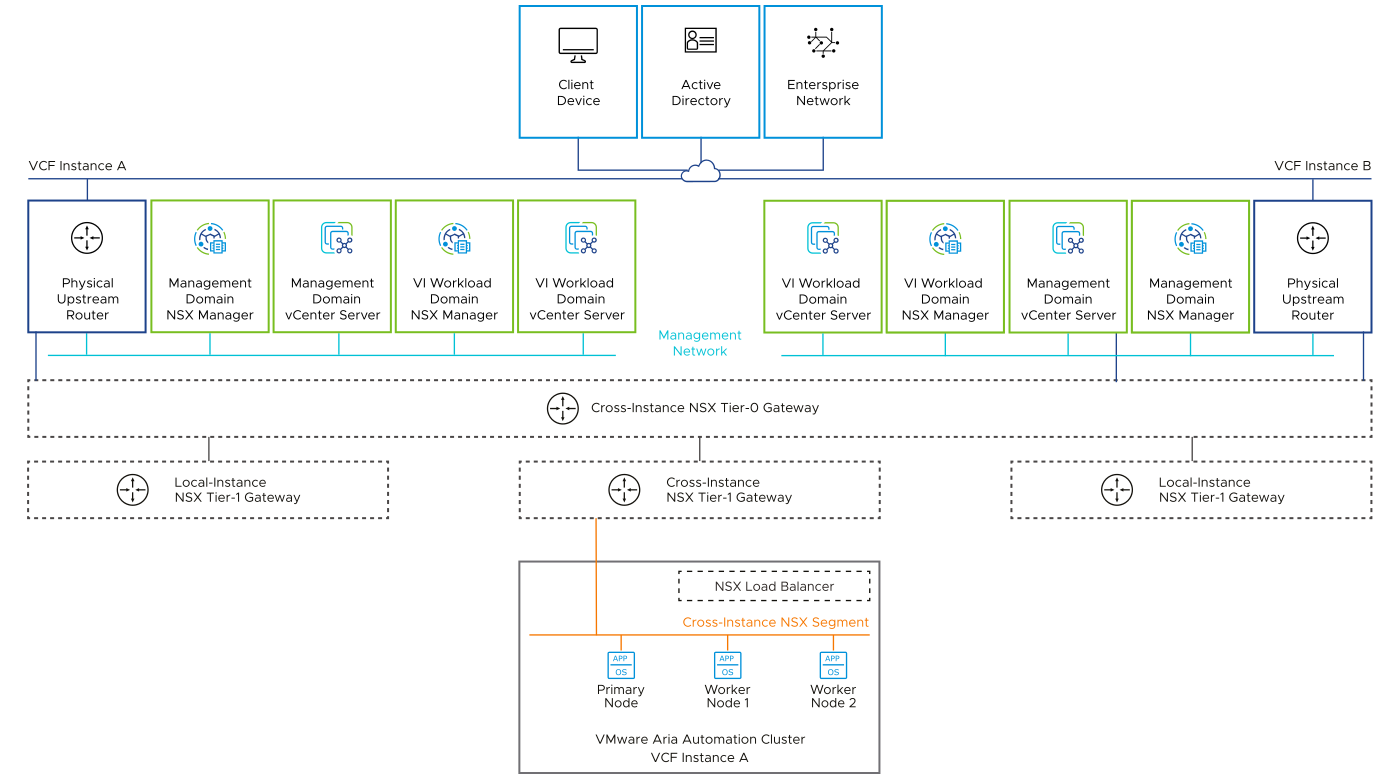For secure access to the UI and API of VMware Aria Automation, you place the cluster nodes on the cross-instance NSX segment. This configuration also supports user access to the VMware Aria Automation cluster.
Network Segment
The network segments design consists of characteristics and decisions for placement of VMware Aria Automation in the management domain.
This validated solution uses an implementation of the VMware Cloud Foundation application virtual networks feature in the management domain provided by NSX. The application virtual networks in the management domain can be either overlay-backed NSX segments or VLAN-backed NSX segments.
| Type |
Description |
|---|---|
| Overlay-backed NSX segment |
The routing to the VLAN-backed management network segment and other networks can use dynamic routing protocols or static routing. Routed access to the VLAN-backed management network segment is provided through an NSX Tier-1 and Tier-0 gateways. Recommended option to facilitate scale out to a multi instance design supporting disaster recovery. |
| VLAN-backed NSX segment |
You must provide one unique VLAN, network subnet, and vCenter Server portgroup name. |

Decision ID |
Design Decision |
Design Justification |
Design Implication |
|---|---|---|---|
PCA-VAA-NET-001 |
Place the VMware Aria Automation cluster nodes on the cross-instance NSX network segment. |
Provides a consistent deployment model for management applications and a potential to extend to a second VMware Cloud Foundation instance for disaster recovery. |
You must use an implementation of NSX to support this networking configuration. |
IP Addressing
Allocate statically assigned IP addresses and host names to the VMware Aria Automation cluster nodes and the load balancer from their corresponding network.
By default, the following network ranges are reserved for the internal Kubernetes configuration in VMware Aria Automation.
| Setting |
Value |
|---|---|
| Kubernetes cluster IP range |
10.244.0.0/22 |
| Kubernetes service IP range |
10.244.4.0/22 |
Decision ID |
Design Decision |
Design Justification |
Design Implication |
|---|---|---|---|
PCA-VAA-NET-002 |
Allocate statically assigned IP addresses from the cross-instance NSX segment to the VMware Aria Automation cluster nodes and the NSX load balancer virtual server. |
Using statically assigned IP addresses ensures stability of the deployment and makes it simpler to maintain and easier to track. |
Requires precise IP address management. |
Name Resolution
Name resolution provides the translation between an IP address and a fully qualified domain name (FQDN), which makes it easier to remember and connect to components across the SDDC. The IP address of each VMware Aria Automation cluster node and the load balancer VIP must have a valid internal DNS forward (A) and reverse (PTR) record.
Decision ID |
Design Decision |
Design Justification |
Design Implication |
|---|---|---|---|
PCA-VAA-NET-003 |
Configure forward and reverse DNS records for each VMware Aria Automation cluster node IP address and for the NSX load balancer virtual server IP address. |
VMware Aria Automation is accessible by using a fully qualified domain name instead of by using IP addresses only. |
|
PCA-VAA-NET-004 |
Configure DNS servers for each VMware Aria Automation cluster node. |
Ensures that VMware Aria Automation has accurate name resolution on which its services are dependent. |
|
Load Balancing
A VMware Aria Automation cluster deployment requires a load balancer to manage the connections to the VMware Aria Automation services.
This validated solution uses load-balancing services provided by NSX in the management domain. The load balancer is automatically configured by VMware Aria Suite Lifecycle and SDDC Manager during the deployment of VMware Aria Automation.
| Load Balancer Element |
Settings |
|---|---|
| Service monitor |
|
| Server pool |
|
| TCP application profile |
|
| HTTP redirect application profile |
|
| Virtual server |
|
| HTTP redirect virtual server |
|
Decision ID |
Design Decision |
Design Justification |
Design Implication |
|---|---|---|---|
PCA-VAA-NET-005 |
Use the small-size NSX load balancer that is configured by SDDC Manager on the dedicated NSX Tier-1 gateway in the management domain to load balance the clustered Workspace ONE Access deployment, to also load balance the connections across the VMware Aria Automation cluster nodes. |
|
You must use the NSX load balancer that is configured by SDDC Manager and the integration with VMware Aria Suite Lifecycle to support this network configuration. |
Time Synchronization
VMware Aria Automation depends on system time synchronization for all cluster nodes. The system time for the VMware Aria Automation nodes, along with dependencies and integrations, such as VMware Aria Suite Lifecycle, Workspace ONE Access, and VMware Aria Operations, must be synchronized and must use the same timezone.
Decision ID |
Design Decision |
Design Justification |
Design Implication |
|---|---|---|---|
PCA-VAA-NET-006 |
Configure NTP servers for each VMware Aria Automation cluster node. |
|
|